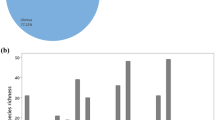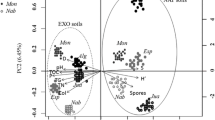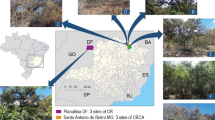Abstract
Ecuador is one of the most biodiverse countries on the planet, and the majority of that biodiversity inhabits the vast Amazon region, of which a considerable number of species are threatened or considered regional endemics. Soil microorganisms are considered important drivers of plant biodiversity; however, little is known about microbial communities associated with the Amazon flora. In this chapter, we present the development of research on mycorrhizae conducted in Ecuadorian Amazon. The flora mycorrhiza status analysis and the diversity of mycorrhiza fungi reported in literature to date suggest that arbuscular mycorrhizal plant families and fungi are dominant in this ecosystem, which is consistent with the hypothesis of AMF being a strategy to sustain plant diversity in low P environments. The key findings from this work are highlighted and presented as a step**-stone for future research. Based on the diversity of just a few fungal species described to date, we consider the exploration of the Amazon microbiological diversity of prime importance.
Access this chapter
Tax calculation will be finalised at checkout
Purchases are for personal use only
Similar content being viewed by others
References
Aleklett K, Body L (2021) Fungal behaviour: a new frontier in behavioural ecology. Trends Ecol Evol 36(9):787–796. https://doi.org/10.1016/j.tree.2021.05.006
Antoine S, Hériché M, Boussageon R et al (2021) A historical perspective on mycorrhizal mutualism emphasizing arbuscular mycorrhizas and their emerging challenges. Mycorrhiza 31:637–653. https://doi.org/10.1007/s00572-021-01053-2
Bahram M et al (2018) Structure and function of the global topsoil microbiome. Nature 560:233–237
Bennett JA, Maherali H, Reinhart KO, Lekberg Y, Hart MM, Klironomos J (2017) Plant-soil feedbacks and mycorrhizal type influence temperate forest population dynamics. Science 355(6321):181–184
Brundrett MC (2009) Mycorrhizal associations and other means of nutrition of vascular plants: understanding the global diversity of host plants by resolving conflicting information and develo** reliable means of diagnosis. Plant Soil 320:37–77
Camenzind T, Hempel S, Homeier J et al (2014) Nitrogen and phosphorus additions impact arbuscular mycorrhizal abundance and molecular diversity in a tropical montane forest. Glob Chang Biol 20(12):3646–3659. https://doi.org/10.1111/gcb.12618. PMID: 24764217
Cevallos S, Sánchez-Rodríguez A, Decock C, Declerck S, Suárez JP (2017) Are there keystone mycorrhizal fungi associated with tropical epiphytic orchids? Mycorrhiza 27(3):225–232. https://doi.org/10.1007/s00572-016-0746-8. PMID: 27882467
Cofré MN, Soteras F, Iglesias M del R, Velázquez S, Abarca C, Risio L, Ontivero E, Cabello MN, Domínguez LS, Lugo MA (2019) Biodiversity of Arbuscular Mycorrhizal fungi in South America: a review. In: Pagano MC, Lugo MA (eds) Mycorrhizal fungi in South America. Springer, Cham, pp 49–72
de Oliveira FR, Buscardo E, Nagy L et al (2014) Arbuscular mycorrhizal fungal communities along a pedo-hydrological gradient in a Central Amazonian terra firme forest. Mycorrhiza 24:21–32. https://doi.org/10.1007/s00572-013-0507-x
Duchicela J, Vogelsang KM, Schultz PA, Kaonongbua W, Middleton EL, Bever JD (2012) Non-native plants and soil microbes: potential contributors to the consistent reduction in soil aggregate stability caused by the disturbance of North American grasslands. New Phytol 196(1):212–222
Dueñas JF, Camenzind T, Roy J et al (2020) Moderate phosphorus additions consistently affect community composition of arbuscular mycorrhizal fungi in tropical montane forests in southern Ecuador. New Phytol 227(5):1505–1518. https://doi.org/10.1111/nph.16641. PMID: 32368801
Ensley-Field M (2016) Nutrient cycling in the Amazon: a comparison of soil characteristics, insects, root types and decomposition rates between Varzea and Terra Firme habitats in the Ecuadorian Amazon. Independent Study Project (ISP) Collection. 2324. https://digitalcollections.sit.edu/isp_collection/2324
Garces M, Senés C, Declerck S, Cranenbrouck S (2017) Arbuscular mycorrhizal fungal community composition in Carludovica palmata, Costus scaber and Euterpe precatoria from weathered oil ponds in the Ecuadorian Amazon. Front Microbiol 8:2134. https://www.ncbi.nlm.nih.gov/pmc/articles/PMC5674942/
Garcés-Ruiz M, Senés-Guerrero C, Declerck S, Cranenbrouck S (2019) Community composition of arbuscular mycorrhizal fungi associated with native plants growing in a petroleum-polluted soil of the Amazon region of Ecuador. Microbiol Open 8(4):e00703. https://doi.org/10.1002/mbo3.703. PMID: 30117306; PMCID: PMC6529925
Gerz M, Bueno CG, Zobel M, Moora M (2016) Plant community mycorrhization in temperate forests and grasslands: relations with edaphic properties and plant diversity. J Veget Sci 27:89–99
Hickey AT (2020) The hidden symbiont: Exploring arbuscular mycorrhizae in the Ecuadorian Amazon. Universidad San Francisco de Quito USFQ institutional repository, theses publishing available on http://bit.ly/COPETheses
Haug I, Setaro S, Suárez JP (2019) Species composition of arbuscular mycorrhizal communities’ changes with elevation in the Andes of South Ecuador. PLoS One 14(8):e0221091. https://doi.org/10.1371/journal.pone.0221091. PMID: 31419262; PMCID: PMC6697372
Hirsch PR, Miller AJ, Dennis PG (2013) Do root exudates exert more influence on rhizosphere bacterial community structure than other rhizodeposits? In: de Bruijn FJ (ed) Molecular microbial ecology of the rhizosphere. Wiley-Blackwell, Hoboken, pp 229–242
John R, Dalling JW, Harms KE, Yavitt JB, Stallard RF, Mirabello M et al (2007) Soil nutrients influence spatial distributions of tropical tree species. PNAS 104(3):864–869
Krüger M, Krüger C, Walker C, Stockinger H, Scübler (2012) Phylogenetic reference data for systematics and phylotaxonomy of arbuscular mycorrhizal fungi from phylum to species level. Available in: https://nph.onlinelibrary.wiley.com https://doi.org/10.1111/j.1469-8137.2011.03962.x
Lambers H, Mougel C, Jailllard B, Hinsinger P (2009) Plant-microbe-soil interactions in the rhizosphere: an evolutionary perspective. Plant Soil 321:83–115. https://doi.org/10.1007/s11104-009-0042-x
Lareen A, Burton F, Schäfer P (2016) Plant root-microbe communication in sha** root microbiomes. Plant Mol Biol 90:575–587. https://doi.org/10.1007/s11103-015-0417-8
Lemanceau P, Blouin M, Muller D, Moënne-Loccoz Y (2017) Let the core microbiota be functional. Trends Plant Sci 22(7):583–595. https://doi.org/10.1016/j.tplants.2017.04.008
Lugo MA, Pagano MC (2019) Overview of the mycorrhizal fungi in South America. In: Pagano MC, Lugo MA (eds) Mycorrhizal fungi in South America. Springer, Cham, pp 1–27
Lunt PH, Hedger JN (1996) A survey of mycorrhizal infection of trees in the terra firme rainforest, Cuyabeno. Ecuador Mycol 10(4):161–165
Mendes R, Garbeva P, Raaijmakers JM (2013) The rhizosphere microbiome: significance of plant beneficial, plant pathogenic, and human pathogenic microorganisms. FEMS Microbiol Rev 37(5):634–663. https://doi.org/10.1111/1574-6976.12028
Moora M (2014) Mycorrhizal traits and plant communities: perspectives for integration. J Veg Sci 25(5):1126–1132
Oehl F, Sieverding E, Ineichen K, Mäder P, Wiemken A, Boller T (2009) Distinct sporulation dynamics of arbuscular mycorrhizal fungal communities from different agroecosystems in long-term microcosms. Agric Ecosyst Environ 134:257–268
Öpik M, Davison J, Moora M, Zobel M (2014) DNA-based detection and identification of Glomeromycota: the virtual taxonomy of environmental sequences. Botany 92:135–147. https://doi.org/10.1139/cjb-2013-0110
Parfrey LW, Moreau CS, Russell JA (2018) Introduction: the host-associated microbiome: pattern, process and function. Mol Ecol 7:1749–1765. https://doi.org/10.1111/mec.14706
Peay KG (2016) The mutualistic niche: mycorrhizal symbiosis and community dynamics. Ann Rev Ecol Evol Syst 47:143–164
Philippot L, Raaijmakers JM, Lemanceau P, van der Puttem WH (2013) Going back to the roots: the microbial ecology of the rhizosphere. Nat Rev Microbiol 11(11):789–799. https://doi.org/10.1038/nrmicro3109
Preußing M, Nebel M, Oberwinkler F et al (2010) Diverging diversity patterns in the Tulasnella (Basidiomycota, Tulasnellales) mycobionts of Aneura **uis (Marchantiophyta, Metzgeriales) from Europe and Ecuador. Mycorrhiza 20:147–159. https://doi.org/10.1007/s00572-009-0275-9
Read DJ (1991) Mycorrhizas in ecosystems. Experientia 47(4):376–391
Read DJ, Pérez-Moreno J (2003) Mycorrhizas and nutrient cycling in ecosystems–a journey towards relevance? New Phytol 157:475C492
Riofrío ML, Cruz D, TE, de la Cruz Rot M, Iriondo JM, Suárez JP (2013) Mycorrhizal preferences and fine spatial structure of the epiphytic orchid Epidendrum rhopalostele. Am J Bot 100(12):2339–2013
Sheldrake M, Rosenstock NP, Revillini D, Olsson PA, Mangan S, Sayer EJ, Tanner EV (2017) Arbuscular mycorrhizal fungal community composition is altered by long-term litter removal but not litter addition in a lowland tropical forest. New Phytol 214(1):455–467
Schreiter S, Ding GC, Heuer H, Neumann G, Sandmann M, Grosch R, Kropf S, Smalla K (2014) Effect of the soil type on the microbiome in the rhizosphere of field-grown lettuce. Front Microbiol 5:144. https://doi.org/10.3389/fmicb.2014.00144
Smith SE, Read DJ (2010) Mycorrhizal symbiosis. Academic Press
Stamets P (2005) Mycelium running: how mushrooms can help save the world. Random House Digital, Inc
Tedersoo L, Sadam A, Zambrano M, Valencia R, Bahram M (2010) Low diversity and high host preference of ectomycorrhizal fungi in Western Amazonia, a neotropical biodiversity hotspot. ISME J 4(4):465–471
Van der Heijden MGA, Martin FM, Selosse MA, Sanders IR (2015) Mycorrhizal ecology and evolution: the past, the present, and the future. New Phytol 205:1406–1423
Wagg C, Bender SF, Widmer F, van der Heijden MG (2014) Soil biodiversity and soil community composition determine ecosystem multifunctionality. PNAS 111:5266–5270
Wang B, Qiu Y-L (2006) Phylogenetic distribution and evolution of mycorrhizas in land plants. Mycorrhiza 16:299–363
Acknowledgments
We thank Fatima Lorena Benitez of the Institute of Geography of Universidad San Francisco de Quito for the creation of the maps of the Amazon Region of Ecuador. We thank Alexander Criollo for his help with the literature search for the Supplementary Table S1.
Author information
Authors and Affiliations
Corresponding authors
Editor information
Editors and Affiliations
Appendix A
Appendix A
Rights and permissions
Copyright information
© 2022 The Author(s), under exclusive license to Springer Nature Switzerland AG
About this chapter
Cite this chapter
Duchicela, J., Valdivieso, A., Prado-Vivar, B., Arévalo-Granda, V., Hickey-Darquea, A., Hof, P.V.‘. (2022). Diversity of Arbuscular Mycorrhizal Fungi in the Ecuadorian Amazon Region. In: Lugo, M.A., Pagano, M.C. (eds) Mycorrhizal Fungi in South America. Fungal Biology. Springer, Cham. https://doi.org/10.1007/978-3-031-12994-0_7
Download citation
DOI: https://doi.org/10.1007/978-3-031-12994-0_7
Published:
Publisher Name: Springer, Cham
Print ISBN: 978-3-031-12993-3
Online ISBN: 978-3-031-12994-0
eBook Packages: Biomedical and Life SciencesBiomedical and Life Sciences (R0)




